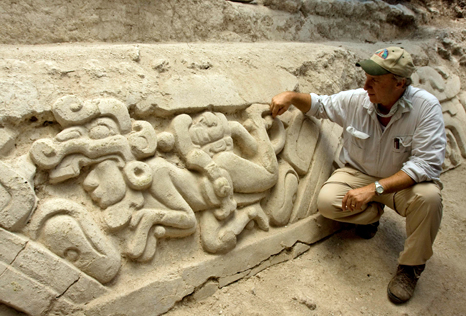|

by Alan Boyle
March 12, 2009
from
CosmicLog Website

Moises
Castillo / AP
Idaho State University anthropologist Richard Hansen shows a
2,300-year-old
stucco frieze found at the El Mirador archaeological site in
northern Guatemala.
Archaeologists have
unearthed a pair of monumental stucco panels in Guatemala that
appear to depict one of the New World's oldest-known creation
stories, going back thousands of years to what experts call "the
cradle of Maya civilization." The discovery suggests that the saga,
known as the
Popol Vuh, was a centerpiece of Maya beliefs for well
more than a millennium and stands as one of the world's enduring
religious stories.
The Popol Vuh chronicles how the Maya gods created the world
and made several attempts to fashion people to live in it, including
"mud people" and "wooden people" that didn't quite meet the grade.
Finally, the gods got it right, creating the people who inhabited
the urban site now known as El Mirador - where the panels were found
- and the hundreds of thousands of acres comprising the Serpent
Kingdom.
A Quiche Maya text of the Popol Vuh was found in the highland town
of Chichicastenango in 1700 and transcribed by a Dominican monk
named Francisco Ximenez. The saga's two main characters are
the Hero Twins, named Hunahpu and Xbanlanque, who are
sort of like a double dose of Hercules.
The 26-foot-long (8-meter-long) El Mirador panels were made of
carved and modeled lime plaster, and lined a water collection system
in a part of the city known as the Central Acropolis. They date back
to the Late Preclassic period of Maya culture, which goes from about
300 B.C. to the early 1st century A.D., according to
an account of
the find from Idaho State University.
The amazing thing about the panels is that they show a pair of
swimmers, framed by cosmic monsters including an undulating
serpent and an old-man deity with outstretched wings.
Idaho State University's
Richard Hansen, president of the Idaho-based
FARES
Foundation, said the swimmers appear to represent the fabled Hero
Twins.
"One of the swimmers
has a decapitated head on his flanks, which is likely the
decapitated head of his father, who was known in Maya mythology
as Hun Hunahpu," Hansen is quoted as saying in the university's
account. The other swimmer wears a jaguar headdress, which would
typically be associated with Xbalanque ("Young Jaguar Sun.").
"All in all, the scene is a complex blend of early Maya
mythology and cosmology," Hansen said.
Hector Escobedo,
Guatemala's vice minister of culture, said the find,
"suggests that the
antiquity of the Popol Vuh as an authentic creation story
extends far into the Preclassic eras."
The find also adds to
the importance attached to
the Mirador Basin as a center of ancient
Maya culture.
Hansen has been doing research for years in the remote Mirador
Basin, which is at the center of a major forest conservation program
established by the Guatemalan government. The Idaho researcher
served as a consultant to actor/director Mel Gibson on the
controversial movie "Apocalypto." And although that film is now far
back on the DVD shelves, Gibson is still taking an interest in Mirador.
Recently, he called the site
"arguably the greatest
archaeological find in the Western Hemisphere."
-
Update for 10 p.m. ET: There's a lot of discussion in the comments
below about the use of the word "myth" - in this context, I meant it
in the same sense that one would talk about Greek or Roman myths.
I've also reworded some references in this item just to avoid using
the word "myth" over and over again.
-
Update for 5 p.m. ET March 18: Here are some thoughtful observations
from anthropologist/archaeologist
James Q. Jacobs:
"I do not know who
chose the title ['Maya Myth Revealed'], but I find it deceptive.
What is revealed is a physical object. The 'myth' aspect is an
interpretation based on writing from about 2,000 years later,
and from a different location. We do not even know if the same
culture group was extant when the Popol Vuh was written.
"The huge distinction between evidence and interpretation is
often overlooked in archaeology in favor of our myths about the
past. Science writers can aid in elucidating this chasm,
especially when the temporal gap is this immense."
I admit that I wrote the
title. Although the archaeologists involved with the dig emphasized
the Popol Vuh connection, Jacobs makes a good point that one (or
two) stucco panels may not be enough to nail down that connection.
|

